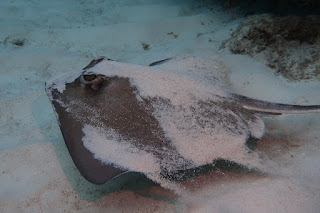First Full Day on the Island 🏝
Our first official day!
We woke up for our first breakfast here at the Gerace Research Center and a group of us headed to town to attend mass at the Holy Savior Catholic Church with Mrs. Gerace herself. It was a very warm, welcoming mass and once we arrived back at the research center we loaded the truck and headed off to start our tour of the island. We were able to see the schools and beautiful houses and stopped along the way to take a quick look around the beautiful beaches we passed. We all agreed to take our lunch at Grado Beach which, in my opinion, was one of the most beautiful beaches I have ever seen. Once we set up, we made our own sandwiches for lunch to fuel up for the snorkeling we had ahead. After our first snorkel and time well spent playing in the surf, we continued our tour around the island, dodging potholes and branches along the way. Our next stop was at the telephone pole reef, where we hopped into our snorkel gear again and ventured out to the buoy bobbing on the surface of the crystal blue waters. Beneath the water was an aquarium of creatures that we are still learning the names of: angle, damsel, surgeon, and parrot fish inhabited the patches of coral reef that lay below. Most notably, we saw our first stingray gliding across the ocean floor and a spiny lobster of a very notable size lurking in its cave. Then we climbed back into the truck and headed to Wendy’s (not your typical fast food spot), a local food stand with delicious ice cream, before arriving back at Gerace and eating dinner.
After dinner, we visited the classroom to discuss two papers on Damselfish recruitment. The first paper, “Self-recruitment in a Coral Reef Population” by Jones et al., looked at damsel fish populations on the Great Barrier Reef and their ability to self-recruit. Recruitment is a fundamental process in the population dynamics of a given species because it determines the number of juvenile individuals that will enter a given population. This paper challenged the predominant belief that most local populations are driven by recruitment from other sub-populations, and their data indicated that as many as 15-60 % of juveniles might return to their initial pollution on Lizard Island.
The second paper was the first empirical representation of the recruitment limitation hypothesis, illustrating that the adult abundance of fish populations can limit recruitment. The paper by Peter Doherty and Tony Fowler, “Self-recruitment in a coral reef population,” looked at recruitment rates compared to adult abundances at several sites on a chain of islands in the Great Barrier Reef. All sites except for one outlier showed a substantial correlation between recruitment patterns and damselfish abundance, giving us an empirical example of the recruitment limitation hypothesis.
All said and done, it was a full, fun, and fished-packed first day. Much like the Gospel reading in today's church service, we were baptized into island life and submerged in the Bahamas. Our extensive tour of San Salvador gave us a great sense of the beautiful place that we get to call home for the next month.
Until tomorrow,
Paola and Logan











Comments
Post a Comment